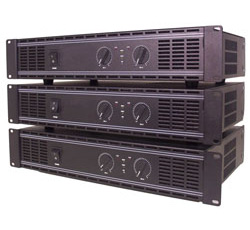
Consider the fact that a loudspeaker with a 500-watt continuous power rating can only be driven slightly harder than one with a 250-watt rating (+3 dB). This means that there is little practical difference between the two regarding power handling, even though there is an apparent large difference in their ratings. If the 250-watt unit has a +3 dB sensitivity rating compared to the 500-watt unit, the former unit could produce the same SPL with one-half of the applied power!
Most power tests modify the pink noise stimulus to have a lower crest factor by clipping the program peaks with an electrical circuit. The practical reason for clipping the waveform is to allow the amplifier to deliver more power to the load. Remember that a power test is all about heat, not about sound.
The maximum amplifier output power for unclipped pink noise is about 1/10th of the amplifier’s sine wave rated power. Clipped pink noise can produce about 1/2 of the amplifier’s sine wave power rating, allowing high power testing with reasonable amplifier sizes.
The clipping artifacts do not contribute significantly to the heating of the loudspeaker (in spite of sounding bad), but the lower crest factor produces more power (higher RMS voltage) into the load.
A continuous power test feeds 6 dB crest factor pink noise to the loudspeaker for a specified period of time (i.e. 2 hours). This is a demanding test for the loudspeaker, since there are no breaks in the program material to allow cooling.
Program power ratings attempt to simulate music or speech by reducing the duty cycle of the waveform. If the noise is pulsed, some cooling can occur between bursts and more short term power can be applied prior to thermal failure.
Many manufacturers estimate the program power rating by doubling the continuous power rating (+3 dB or 2x is a reasonable assumption).
The actual recommended amplifier size will be larger than either of these ratings. A reasonable estimate is the continuous power rating +6 dB (4x). Given these definitions, a complete and meaningful power rating for a loudspeaker might be:
Maximum Input Power 100W/200W/400W
(continuous, program, rec. amplifier size)
or better yet
Maximum Input Power 20dBW/23dBW/26dBW
(continuous, program, rec. amplifier size)
Once can easily see the problem with comparing loudspeaker power ratings. It takes a lot of research to assure an “apples to apples” comparison, and many specs simply don’t include enough background information to allow this.
Contrary to urban legend, there is no danger to a loudspeaker from feeding it less than its rated power. In fact, it will have a longer, happier life if it runs at a cooler temperature.
